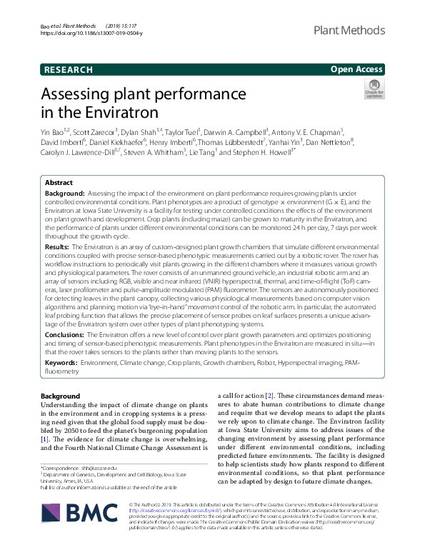
Background: Assessing the impact of the environment on plant performance requires growing plants under controlled environmental conditions. Plant phenotypes are a product of genotype × environment (G × E), and the Enviratron at Iowa State University is a facility for testing under controlled conditions the effects of the environment on plant growth and development. Crop plants (including maize) can be grown to maturity in the Enviratron, and the performance of plants under different environmental conditions can be monitored 24 h per day, 7 days per week throughout the growth cycle.
Results: The Enviratron is an array of custom-designed plant growth chambers that simulate different environmental conditions coupled with precise sensor-based phenotypic measurements carried out by a robotic rover. The rover has workflow instructions to periodically visit plants growing in the different chambers where it measures various growth and physiological parameters. The rover consists of an unmanned ground vehicle, an industrial robotic arm and an array of sensors including RGB, visible and near infrared (VNIR) hyperspectral, thermal, and time-of-flight (ToF) cameras, laser profilometer and pulse-amplitude modulated (PAM) fluorometer. The sensors are autonomously positioned for detecting leaves in the plant canopy, collecting various physiological measurements based on computer vision algorithms and planning motion via “eye-in-hand” movement control of the robotic arm. In particular, the automated leaf probing function that allows the precise placement of sensor probes on leaf surfaces presents a unique advantage of the Enviratron system over other types of plant phenotyping systems.
Conclusions: The Enviratron offers a new level of control over plant growth parameters and optimizes positioning and timing of sensor-based phenotypic measurements. Plant phenotypes in the Enviratron are measured in situ—in that the rover takes sensors to the plants rather than moving plants to the sensors.
Available at: http://works.bepress.com/lie_tang/50/

This article is published as Bao, Yin, Scott Zarecor, Dylan Shah, Taylor Tuel, Darwin A. Campbell, Antony VE Chapman, David Imberti, Daniel Kiekhaefer, Henry Imberti, Thomas Lübberstedt, Yanhai Yin, Dan Nettleton, Carolyn J. Lawrence‑Dill, Steven A. Whitham, Lie Tang, and Stephen H. Howell. "Assessing plant performance in the Enviratron." Plant Methods 15, no. 1 (2019): 117. DOI: 10.1186/s13007-019-0504-y. Posted with permission.